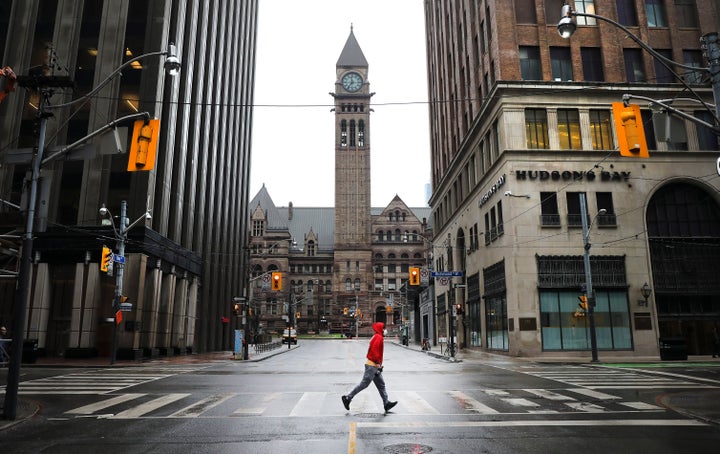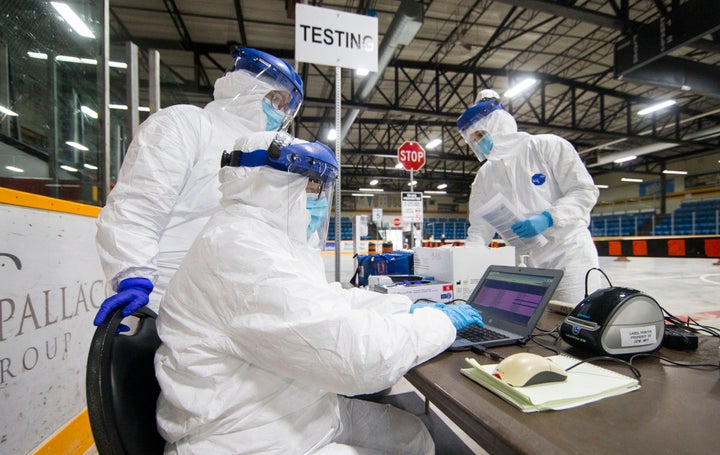Almost two months after most of Canada fell under social distancing guidelines to slow the spread of the novel coronavirus, some provinces are beginning to talk about reopening — but questions about how to do so safely remain.
Saskatchewan last week became the first province to release a detailed plan of how it will reopen its economy, with the first phase of its five-phase plan beginning May 4. Prince Edward Island and Quebec have also announced they will begin easing restrictions in early May, while New Brunswick has already begun to loosen some of its physical distancing measures.
In Ontario, Premier Doug Ford on Monday released the province’s plan to reopen, but did not offer specific dates. “Hopefully if we can see the numbers come down over the next couple of weeks we will be able to lighten up the measures,” he said.
Prime Minister Justin Trudeau has said life will not return to normal until a vaccine is available.
With the growing number of sometimes-conflicting statements on reopening from politicians and public health officials, Canadians are left wondering what it will take to return to some sense of normalcy — and when that can happen.

Susan Bondy, an epidemiologist and associate professor at the Dalla Lana School of Public Health at the University of Toronto, said one concern around a gradual reopening of society is that people will still be at risk of contracting the virus — especially those who are vulnerable because of their age or existing health conditions.
“It might not feel like we’re in peril right now because we’re so locked down, but most people who study epidemics will say that as the average number of people everybody comes into contact with rises, we can expect recurring outbreaks,” Bondy told HuffPost Canada.
She points out that right now, almost everyone except essential workers is following the same set of rules: Stay home except for essential needs like getting groceries or medical care.
But as officials begin to relax some guidelines and reopen sectors of the economy, the new protocols may create confusion or conflict between people if they are not equally enforced. For example, one hair salon may rely on physical distancing but not require employees to wear personal protective equipment, while another might require masks and gloves and constant sterilization of tools.
This means it’s important for everyone to know the updated rules — and on which websites to find reliable information — as well as to have clear signage posted in public places, Bondy said.
Overall, Bondy said she agrees with public health officials that the reopening needs to be gradual and incremental — and if it leads to more infections, we need to be prepared to tighten measures again.
Widespread testing, contact tracing key
One factor experts say is important to consider when it comes to lifting social distancing requirements is who is being tested for COVID-19.
Ontario’s COVID-19 testing guidelines — updated as of April 15 — call for the testing of symptomatic hospital inpatients, residents and workers in long-term care or retirement homes and other congregate care settings, as well as health-care workers, people living in the same house as health-care workers, people in remote or Indigenous communities, people who have underlying health conditions, essential workers and cross-border workers.
The guidelines say that testing of asymptomatic people is “generally not recommended” unless it is directed by a public health unit as part of outbreak management in a communal care setting, such as a long-term care home.
“To be able to relax social distancing, we need to be able to test everyone who is symptomatic and wants to be tested, and perhaps even more importantly, we need to be able to contact trace every positive case,” Dr. Lauren Lapointe-Shaw, a physician and associate professor of medicine at the University of Toronto, told HuffPost in an email.
Contact tracing means that after someone is tested and receives a positive result, they are interviewed by public health about everywhere they went, and everyone they had contact with, in the one or two-week period leading up to their test. The public health investigator will then reach out to those people, and in some cases, the businesses or locations that the confirmed case visited.

Widespread testing also matters because evidence shows that people who don’t display symptoms can still spread COVID-19.
Dr. Isaac Bogoch, an infectious diseases specialist at the University of Toronto and Toronto General Hospital, told the Toronto Star that he breaks up asymptomatic people into three categories: those who are “pre-symptomatic” and will develop symptoms after testing positive, people who show no symptoms at all, and people who have mild symptoms but don’t associate them with COVID-19.
“When we fully understand who’s truly asymptomatic, it will likely be one of several important components that drives the epidemic,” Bogoch said.
Dionne Aleman, a professor of industrial engineering at the University of Toronto, noted that testing needs to be not just widespread, but also random.
She pointed to the example set by Iceland, where the government said it has tested a higher proportion of its citizens than anywhere else in the world. Data from the country suggests a significant number of people who tested positive were asymptomatic or had mild symptoms.
“That’s something that we need to do, and that we need to understand, before restrictions can be lifted in any meaningful way,” she told HuffPost.
Without widespread testing, if there are more positive cases than we know, “when we start lifting restrictions and all of these positive people start intermingling with everyone else, they can start infecting a lot of people and we can experience a second wave of COVID-19 [likely] far worse than this first wave,” Aleman said.
“That’s not something that we can plan for, unless we actually know COVID-19 prevalence in our population.”
Bondy said the important reopening indicator to look at is not necessarily on the publicly available charts and graphs. While the number of ICU cases is valuable for describing the health-care system’s capacity, what we want to see is a decreasing number of new infections — especially ones not traced to an existing COVID-19 case, she said.
“We’re doing OK if new cases identified are already part of a contact tracing network, that you already had them in isolation, or you already knew that they were potentially exposed,” Bondy said. “Even one case arising where you have no idea where they contracted it is a sign of unrecognized transmission in the community.”
The number of cases linked to community spread is being monitored internally by public health and by Ontario’s COVID-19 command table, Bondy said.
“It's not a sprint, it's a marathon.”
- Susan Bondy, epidemiologist
Among the criteria set out by the Ontario government to advise on reopening is that approximately 90 per cent of new COVID-19 contacts should be contacted by public health officials within one day to give guidance on self-isolation.
But Dr. David Naylor, who is on the leadership committee of Canada’s COVID-19 Immunity Task Force, told the CBC that he is concerned about testing and tracing capacity.
“I think public health units are up to the job. But they do need to have a high level of human resource capacity. And they need to be able to maintain it,” Bondy said. “It’s not a sprint, it’s a marathon.”
Questions about immunity remain
More widespread testing would mean we can have more confidence in our data and modelling about COVID-19 cases, Lapointe-Shaw said.
“Lots of these models, predictions that go out over the next 12 to 18 months, take into account this idea of what level of population spread would be needed to sort of have a herd immunity developed,” she said.
“If we have a whole bunch of people who have already had COVID-19, but we’re not actually catching them through testing, it’s possible that our levels of population spread are higher than we think, which means we may actually be further along in developing some of that herd immunity than we think we are at this point.”
But she noted we don’t know for sure whether someone who has had COVID-19 once is immune from contracting it a second time. The World Health Organization has taken a similarly cautious tone, tweeting, “We expect that most people who are infected with #COVID19 will develop an antibody response that will provide some level of protection” but noting that the level of protection, and how long it lasts, is currently unknown.
WATCH: Prime Minister Justin Trudeau says it is too early to discuss immunity passports. Story continues below.
Dr. Theresa Tam, Canada’s chief medical officer of health, said Canadians should also be cautious about the idea of herd immunity in this outbreak, which would require a large percentage of the population to get infected and develop immunity to reduce the public risk of infection. She noted many people would still get seriously sick, even if we can prove that lasting immunity is possible.
“Herd immunity discussed in the context of natural infection means people will die unnecessarily and it’s a terrible plan,” tweeted infectious disease specialist Amy Greer.
Background serological testing — blood-based testing that can identify whether someone has been exposed to the virus — can show if someone has already had COVID-19. With the caveat of the unknowns about whether previously infected people are immune from contracting COVID-19 again, serological testing could help to determine levels of herd immunity.
Trudeau has said the Canadian government will spend $350 million to expand national testing and modelling of COVID-19. It also created a COVID-19 immunity task force with a leadership team including Naylor and Tam. Their work will include creating a strategy for serology testing, with the goal of collecting at least one million samples over the next two years, as well as looking at the question of whether those who have had COVID-19 are immune to it, and if so, for how long.
What about other waves of the virus?
A major concern with starting to lift social distancing measures is that there could be multiple waves of the virus — especially if we don’t have the herd immunity that some think we do, or if people who have contracted COVID-19 once aren’t immune from contracting it again.
At the beginning of April, Trudeau said there will likely be smaller outbreaks of COVID-19 after the first wave is over, possibly during the summer.
Harvard researchers suggested in a study released mid-April that “to mitigate the possibility of resurgences of infection, prolonged or intermittent periods of social distancing may be required” until or into 2022.
The possibility of a surge in cases after relaxing social distancing measures makes it even more important to have a “strong buffer” of personal protective equipment, ventilators and other resources at public health units and hospitals, Lapointe-Shaw said.